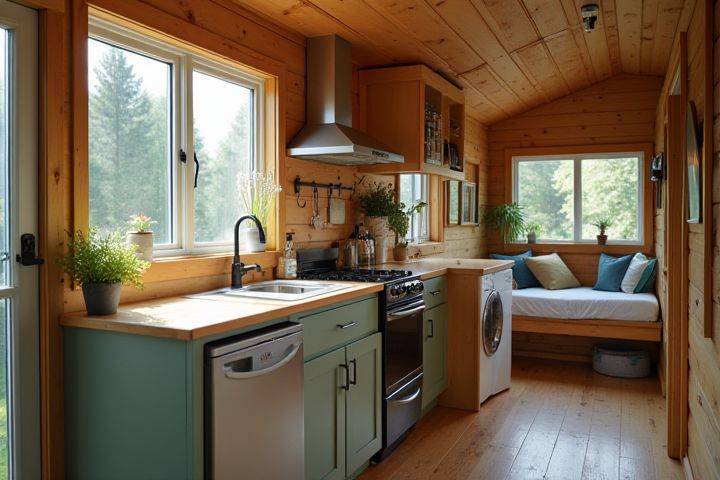
Living in a tiny house full-time is a viable option for many individuals seeking a minimalist lifestyle, financial freedom, or environmental sustainability. These compact homes typically range from 100 to 400 square feet, incorporating multifunctional furniture and efficient use of space to maximize comfort. You'll benefit from reduced living expenses, lower utility bills, and less upkeep compared to traditional homes, allowing you to allocate resources towards experiences or savings. However, zoning laws and building regulations can vary by location, so it's essential to research your area's policies before making a commitment. Embracing a tiny house lifestyle often fosters a stronger connection with nature and a community-focused living experience.
Can You Live In A Tiny House Full-Time
Local zoning laws and regulations
Living in a tiny house full-time can be a rewarding experience, but it's essential to understand local zoning laws and regulations governing such dwellings. Many municipalities have specific codes addressing minimum dwelling sizes, permitted land use, and occupancy limits that could affect your ability to reside in a tiny home. Some regions may allow tiny houses as primary residences, while others may restrict them to temporary use or specific areas, such as RV parks or tiny home communities. Before making your move, you should thoroughly research your local regulations to ensure compliance and avoid potential legal issues.
Limited space for storage
Living full-time in a tiny house necessitates efficient use of limited storage space, emphasizing decluttering and creative organization. Every square inch counts, so incorporating multifunctional furniture, such as a sofa bed or a fold-out table, maximizes utility without compromising comfort. Vertical storage solutions, like wall-mounted shelves and hooks, can help keep items accessible while minimizing floor space consumption. To thrive in such an environment, you'll need to adopt a minimalist lifestyle, prioritizing essential belongings and innovative storage techniques.
Minimal environmental impact
Living in a tiny house full-time can significantly reduce your environmental impact, as these homes typically range from 100 to 400 square feet, consuming less energy and resources. By utilizing sustainable materials and energy-efficient appliances, you can minimize your carbon footprint while maintaining a comfortable living space. Many tiny houses are designed to be mobile, allowing you to choose locations with access to renewable energy sources, such as solar power. Embracing a minimalist lifestyle not only promotes a more sustainable way of living but also encourages you to prioritize experiences over possessions, fostering a deeper connection with your surroundings.
Cost-effective living
Living full-time in a tiny house can significantly reduce your living expenses, making it an appealing option for cost-effective living. With lower utility bills, minimal maintenance costs, and the ability to live mortgage-free, tiny homes promote financial freedom. By downsizing, you can also declutter your life, reducing the need for excessive consumer goods. Embracing a minimalist lifestyle allows you to prioritize experiences over material possessions, enhancing your overall quality of life.
Energy efficiency
Living in a tiny house full-time can significantly enhance your energy efficiency. By utilizing solar panels, high-quality insulation, and energy-efficient appliances, you can drastically reduce your carbon footprint. The compact design requires less energy for heating and cooling, minimizing utility costs and environmental impact. Your lifestyle can also promote sustainable habits, as a smaller living space encourages mindful consumption and a reduced reliance on resources.
Creative design utilization
Living in a tiny house full-time can be a rewarding experience, particularly for those who embrace creative design utilization. With an average size between 100 to 400 square feet, these compact homes encourage innovative storage solutions and multifunctional spaces. For example, incorporating built-in furniture such as foldable beds or expandable tables can maximize usability while maintaining a minimalist environment. By focusing on efficient layouts and sustainable materials, you can create a functional and aesthetically pleasing living space that enhances your lifestyle.
Community acceptance and support
Living in a tiny house full-time can greatly benefit from strong community acceptance and support, as it encourages a sense of belonging and shared resources. Many tiny house enthusiasts report improved relationships with neighbors, fostering a collaborative environment where skills and services are exchanged. In areas where tiny living is embraced, residents often find local advocacy groups that provide resources, legal guidance, and social activities tailored to tiny home dwellers. Your experience in a tiny house is likely to be more enjoyable and sustainable when you actively engage with a welcoming community that values diverse living arrangements.
Reduced maintenance needs
Living full-time in a tiny house significantly reduces maintenance needs, allowing for a simpler lifestyle. With fewer square feet, your cleaning and upkeep time diminishes, and this small space often requires only basic repairs. Tiny houses typically utilize efficient materials and systems, making them easier to maintain compared to traditional homes. By minimizing your possessions, you can streamline home care, leading to more free time and less stress.
Potential mobility opportunities
Living full-time in a tiny house offers significant mobility opportunities, allowing you to relocate easily as your needs change. With sizes typically ranging from 100 to 400 square feet, these homes are designed for efficient living and can often be towed by vehicles with a sufficient towing capacity, such as trucks or SUVs. This lifestyle not only reduces your ecological footprint by encouraging simplicity and minimalism but also provides the freedom to explore various locations without the commitment of a traditional mortgage. You can park your tiny house in diverse environments, from urban backyards to rural settings, maximizing your living experience and connection with nature.
Simplicity and minimalist lifestyle
Living in a tiny house full-time encourages a minimalist lifestyle, emphasizing simplicity and intentionality. With an average size of 100 to 400 square feet, tiny homes require efficient use of space, often incorporating multifunctional furniture. Many individuals report a decreased cost of living, with savings on utility bills averaging 60% compared to traditional homes. Embracing this lifestyle can lead to a more sustainable existence, minimizing your ecological footprint while maximizing personal freedom and creativity.
